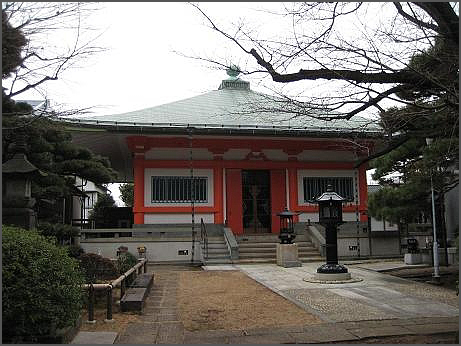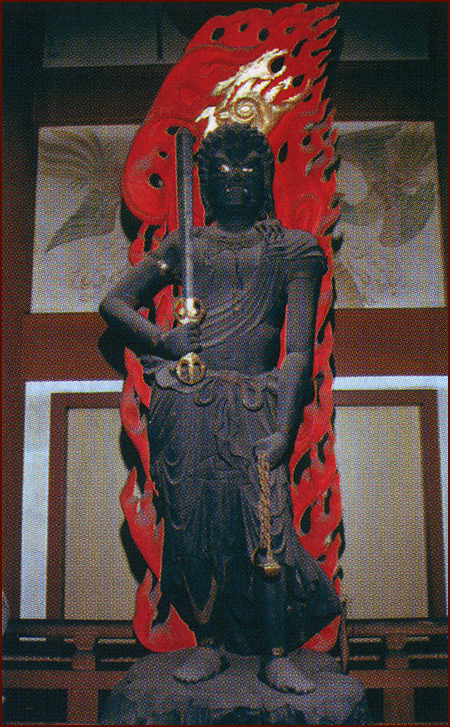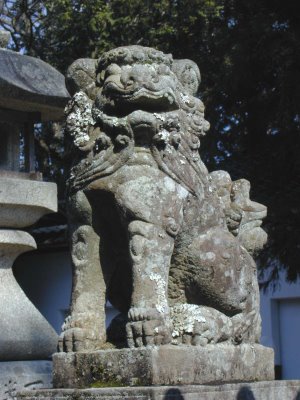- BACK to the Daruma Museum -
. Japanese legends and tales 伝説 民話 昔話 - Introduction .
::::::::::::::::::::::::::::::
Tengu no Ma 天狗の間 - 伝説 Legends about the Tengu Room
Tengu-no-ma - "Tengu's Room", Tengu ("Long-Nosed Goblin") room
. Tengu 天狗と伝説 Tengu legends "Long-nosed Goblin" .
- Introduction -
- - - - -and konoshiro このしろ fish legends, see below
::::::::::::::::::::::::::::::
- - - - - ABC List of the prefectures :
..............................
羽咋村 Hakui
In the home of the 雄谷家 Oya family, there is Tengu Room. From time to time they hear the sound of drums and flutes from there.
..............................
吉野郡 Yoshino district 野迫川村 Nosegawa vilage
At the pass 陣ヶ峰峠 Jingamine Toge there is the tea stall 天狗見茶屋 Tengumi Chaya with a room of 8 tatami mats, the Tengu no Ma 天狗の間 Tengu Room.
The son of this family, 仙太郎 Sentaro, was quite a Yakuza hanging around gambling. So the Tengu came to teach him a lesson and waited in front of the house.
But Sentaro did not listen to his sermon and instead invited him to come along gambling. The angry Tengu picked up the young man and threw him into the large Tengu Room. Sentaro was quite surprized, fell ill and soon died. That is how the room got its name.
..............................
Tengu no ma no yuurei 天狗の間の幽霊 The Ghost of the Tengu Room

This room is located in the 5th floor of 松江城 Matsue castle.
Once upon a long time, the new lord of Matsue castle wanted to relax in the Tengu Room of the main castle tower.
Suddenly a lovely maiden with a robe from the Heian period came right out of the back wall.
The lady told the lord:
"This castle (konoshiro) belongs to me. I want to have it back. Please leave here at once!"
The young lord soon realized that this was something quite unusual and thought about it for a while. Then he told the maiden:
"If you want (kono shiro この城) this castle so much, I will give it to you. Please wait here for a while!"
He left the Tengu Room and went to the local fishermen to get some fish, which was called
konoshiro コノシロ (Konosirus punctatus).

But the fishermen were too afraid to walk up to the Tengu Room.
So the lord said:
"Well, then, I will bring her the fish!"
As he said so, a young retainer called 久弥 Kyuya came up and said:
"I will carry it up to the Tengu Room."

Kyuya placed the fish on a 三方 ritual tray for Shinto offerings and then went up all the stairs to the castle tower to the Tengu Room.
Nobody was in the room when Kyuya placed the tray with the fish on the ground.
Then the lovely maiden with a robe from the Heian period came out of the back wall.
She looked quite puzzled at the tray: "What is this supposed to be?"
Kyuya answered:
"This is Konoshiro, a fish. So please accept it as promised."
The lady hesitated.
"Please, accept the offering!" Kyuya insisted.
So she took the tray.
Indeed, the young Lord had succeeded in fooling the maiden and keeping her promise.

- - - - - Tengu no Ma, the Tengu Room
Next morning Kyuya found the tray near the central Honmaru building of the castle.
And the Lovely Lady was never seen again.
She had been a "human offering" when the castle was built. By mistake not a girl from the village but the daughter of the first owner of the castle had been burried.
. hitobashira 人柱 "human pillar" - human sacrifice .
- Introduction -
..............................
- Matsuo Basho, Oku no Hosomichi 奥の細道:
"I went to see the shrine of Muronoyashima. According to Sora, my companion, this shrine is dedicated to the goddess called the Lady of the Flower-Bearing Trees, who has another shrine at the foot of Mt.Fuji. This goddess is said to have locked herself up in a burning cell to prove the divine nature of her newly-conceived son when her husband doubted it. As a result, her son was named the Lord Born Out of the Fire, and her shrine, Muro-no-yashima, which means a burning cell.
It was the custom of this place for poets to sing of the rising smoke, and for ordinary people not to eat
このしろといふ魚 konoshiro, a speckled fish, which has a vile smell when burnt."
"Pay our respects to the Muro-no-Yashima Shrine.
Companion Sora relates: "The goddess here, Princess Konohanasakuya, is the same as at Mt. Fuji. She set fire to the birthing hut in proof of her wedding vows, so this place graced with the birth of Prince Hohodemi, and, from this, the shrine is called Muro-no-Yashima.
This is why the reading of smoke is practiced here."
They say that this fish when cooked gives off the smell of burning human flesh and therefore is associated with the Lady of the Flowerbearing Trees. This is also why people are forbidden to eat this fish.
. Station 4 - Muronoyashima, Muro no Yashima 室の八嶋 .
..............................
. WASHOKU - Japanese Food Saijiki .
shad, gizzard shad, spotted shad 鮗 (このしろ)
Konosirus punctatus, Clupanodon punctatus
- kigo for all autumn -
shinko しんこ/ シンコ(新子) the smallest kohada fish
kohada 小鰭(こはだ) the bigger fish
konoshiro このしろ the grown fish
By changing its name, this fish is a typical "career fish" (shusse sakana) and thus auspicious for festival food.
..............................
. Japanese Legends - 伝説 民話 昔話 – ABC-List .
..............................
愛媛県 Ehime 西条市 Saijo
Children which are born in an unusual position should not eat Konoshiro fish all their life long.
..............................
香川県 Kagawa 三豊郡 Mitoyo district 高瀬町 Takase
At the shrine 日枝神社 Hie Jinja the fish Konoshiro is used as a kind of amulet to avoid disaster and crying at night by children.
This also holds for children born in the year Showa 24, 25 and 52.
.
If a healthy person all of a sudden and for no good reason looses his health, it will often find an unusual death.
People can use the fish Konoshiro as an offering to avoid disaster. It is best to see the Shrine priest, because he can take a look at the face and make an apropirate diagnosis.
..............................
- reference : Nichibun Yokai Database このしろ -
..............................
江戸橋や鮗(このしろ)つもるふじの雪
Edobashi ya konoshiro tsumoru fuji no yuki
Edobashi bridge !
the snow of Mount Fuji
heaps up on Konoshiro fish
錐水 / 江戸弁慶 Edo Benkei / "Edo's tough men"
A haikai anthology compiled by Ikenishi Gonsui, 1680.
..............................
すゞし江に鮗をうつ竿の露
suzushie ni konoshiro o utsu sao no tsuyu
加舎白雄 Kaya Shirao (1738 – 1791)
..............................
. Osakabe no kami おさかべの神 at Himeji Castle .
Osakabe no Miko, a Yokai 妖怪 monster.

source : emmastyle.jp/articles/detail
::::::::::::::::::::::::::::::
At 横川の大師 the Temple of Yokawa Daishi at Mount Hieizan, there is a Tengu Room. It is locked up with nails on all four sides.
Sometimes people can hear the sound of wings flapping inside.
. Myoogu, Myōgu 明救 Priest Myogu, Hieizan .
Tenjiku Tengu 天竺天狗 The Tengu from India, turned human.
::::::::::::::::::::::::::::::

横浜を愛した昭和の文豪「大佛次郎 天狗の間 今昔散歩」
The famous author Daibutsu Jiro loved Yokohama.
. 大佛次郎 Daibutsu Jiro (1897 - 1973) .
::::::::::::::::::::::::::::::
- reference : nichibun yokai database 妖怪データベース -
- reference : "天狗の間" -
..............................
. Legends about Kobo Daishi Kukai - 弘法大師 空海 - 伝説 .
. Japanese legends and tales 伝説 民話 昔話 - Introduction .
- Yookai 妖怪 Yokai Monsters of Japan -
- Introduction -
::::::::::::::::::::::::::::::

. Join the friends on Facebook ! .
- #tengunoma #tenguroom #konoshiro -
::::::::::::::::::::::::::::::
[ . BACK to DARUMA MUSEUM TOP . ]
[ . BACK to WORLDKIGO . TOP . ]
::::::::::::::::::::::::::::::
--
Posted By Gabi Greve to Heian Period Japan on 12/20/2016 10:42:00 am











































